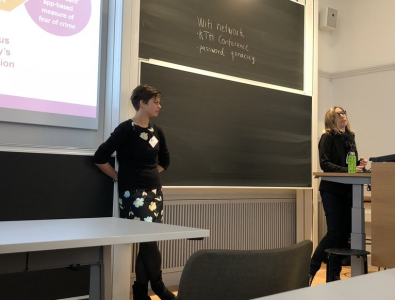Safe Places Through Technological Innovation
Posted on 1 November 2018
Safe Places Through Technological Innovation
 Image courtesy of Reka Solymosi
Image courtesy of Reka SolymosiBy Reka Solymosi, Software Sustainability Institute Fellow
This October I attended Crime and fear in public places: Patterns, challenges and actions, an event exploring the topic of safety in public places, with a particular focus on technological developments that have evolved this area of policy and research. In this blog post, I summarise some of the interesting things I learned at the event, but also highlight how the development of the tools was not much of a focus of the conference.
On 16th - 18th October, I attended this event hosted by the Säkraplatser network, which means ‘safe places’ in Swedish. The event was different from traditional academic conferences as it focused not only on research papers, but also on people’s (in particular womens’) experiences of safety in public places. It was called “Crime and fear in public places: Patterns, challenges and actions ”. There were some academic presentations, but also sharing of personal experiences, for example a talk by the mother of Ida Johansson, who was murdered while jogging in a Stockholm suburb. Within this combination of presentations there was also a strand about the role that technology and software can play in enhancing safe space creation. Of particular interest to me were these presentations that emphasised the growing role that technology can play in learning more about people’s experiences with safety, victimisation, but also in empowering people, and helping both communities and law enforcement create safe places for all.
One such presentation was about the platform safecity.in. The presentation was by Supreet K Singh who is a partner in the Safecity project working specifically on campaigns to engage women and men in solutions to the global issue of sexual harassment and violence against women and girls. Safecity is a crowdsourcing web platform and mobile application to enable people to report their experiences of victimisation. This is important because traditionally this time of victimisation is very under-reported, often people are too traumatised, or they think the incident is not serious enough to report to police, or sometimes fear re-victimisation from the police themselves, a particular problem in India, said Supreet. The platform they developed has served as a platform not just for data collection, but as a starting point for community engagement, and grassroots activism, to be able to address the issue of sexual harassment and victimisation in India. The platform was described as a great leap forward. However there was not much discussion around platform design or the software development that went into this tool, which I would have liked to hear more about.
Another case of technology being used for safety of communities was the safeland app. This was presented by Per Källgården who described the application and its use. Essentially, it is a sort of neighbourhood watch, but online, where people can sign in, create closed communities, and discuss issues about their neighbourhoods. However, it’s also possible to make an alert using the app, and ask for help from the community and from emergency services. Per described a situation in Gamla Stan, the old town of Stockholm, where many shop owners created a community, and could pass alerts to each other, and ask for help when they felt vulnerable against an aggressive customer, or potential shoplifter. This video also describes the ideology behind the application. Interestingly, it is used in the London borough of Hackney, as well as in Sweden, and they are looking to expand. After this presentation, I had some questions around the role of everyday citizens in this sort of thing, and in particular relating to issues around vigilantism, which I got to discuss with the presenter after the session. Again in this case there was no discussion around the software side of things, and the software is proprietary in this case.
Finally, my presentation with my colleagues was about using technology to measure people’s perception of safety. We ran an experiment, where we showed people video recording of walking through an area with all known correlates of fear of crime, identified from the literature, and then we asked people to self-report when they feel unsafe using a mobile app which I developed. We correlated people’s self report with physiological measures of anxiety response, in particular galvanic skin response and heart rate. The video can be viewed here, and is open for use in other research projects. I had to build the software of the application for self-report, a simplified version of the app I wrote for my PhD. It’s so interesting that there was no focus on this at all, building this tool received the same amount of thought in the presentation of the research as purchasing the skin response measure. Just like the other presentations about technology, I realised that the focus of the audience is on how these tools help gain insight into their topic of interest, but not about how these tools are developed. I hope that maybe some readers of the Institute's blog might be interested, and if so, will get in touch to ask about this. In any case, the code for the app is available on Github.
Overall it was a very interesting two days. There were great presentations outside the technology streams, in particular the presentation by Prof Vania Ceccato about a project modelling environmental features of places of outdoor rape in Stockholm, which used an interesting technique combining epidemiology and GIS, and another presentation mapping open air drug markets that was presented by Swedish police analysts. I was grateful to attend this event, and have come away with questions thinking about how to emphasise the role of the software development in these applications.
If you wish to discuss this post with us, send us an email or contact us on Twitter @SoftwareSaved.

